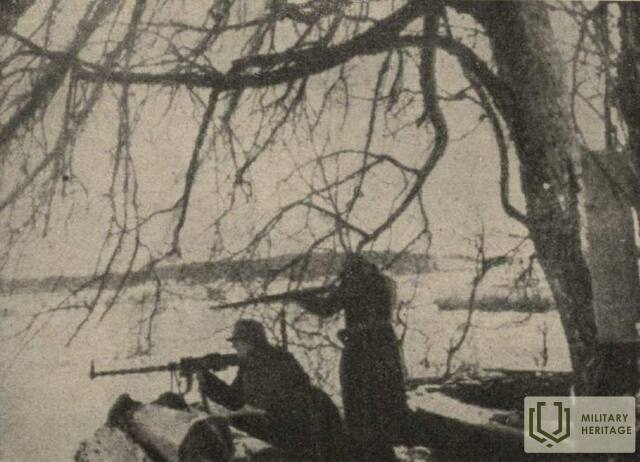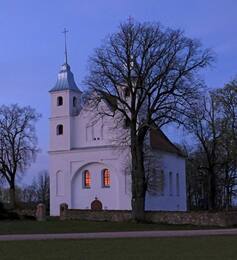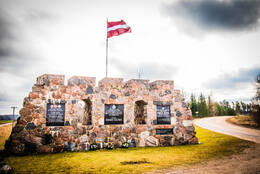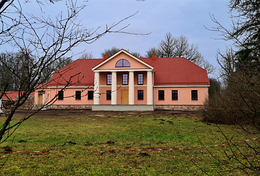Kapitono Aleksandro Levingo prisiminimai apie žvalgybą virš Ventos prie Lenos
1919 m. vasarį abipus Ventos upės aktyviai veikė žvalgybinė veikla. Kapitonas Aleksandras Loevingas, kavalerijos divizijos viršininkas, buvo vienas iš žvalgybinių reidų vadų.
Dar vienas įsimintinas skautų žygis buvo vasario 12 d. Ankstų rytą 8 raitelių grupe važiavome į Leną. Palikę arklius prie sargybos dalinio, pėsčiomis nuėjome per Ventą į kitą krantą, kur po skardžio priedanga pradėjome judėti į šiaurę. Praėjome pro Pikulius, kur buvo žinoma, kad ten stovėjo vienas raudonasis būrys. Po to judame į Biržniekus. Prie šių namų buvo akivaizdus judėjimas, matėsi kai kurie vežimėliai. Paprašiau ltn (vėliau pulkininko) Eime ten su raiteliais. Aš pats ir kiti grįžome į mūsų Ventos pakrantę, užimdami pozicijas miško pakraštyje prie Kurmio, kad galėčiau padėti su ugnimi ir pan. Sumuškite grupę ir uždenkite jos išvykimą. Stambūs vyrai netrukus pastebėjo mūsų žvalgus ir norėjo juos išsiųsti atgal. Atidengėme ugnį, sukeldami didelę sumaištį priešo pusėje. Na, mūsų grupei jau pats laikas išvykti. Bijojau, kad neįkristų į upę, nes daug kur nebuvo ledo sluoksnio. Aš nuėjau su vltn. Atšaka atgal per upę, spygliais pažymėdamas perėjimo vietą. Paskui šliaužėme per pakrantės krūmus pažiūrėti, kur mūsų grupė apsistojo. Dengiamasis gaisras iš Kurmų girios pakraščio vis dar tęsėsi. Staiga vos už 100 metrų pamatėme raudonųjų grupę, kuri išbėgo iš šalia esančio miško. Pradėjome šaudyti tiek, kiek galėjome, iš stovimos padėties, siekdami sužavėti varžovą ir morališkai. Susirėmimas baigėsi skubotu didžiūnų pasitraukimu iš Biržniekų. Visi grįžome sveiki ir sveiki, ir tuo pačiu prakaitu. Su dainomis nuvažiavome pas Leną, kur su žinute pulkininkui sėdome ant žirgų jodinėti į Rudbaržius.
Kripen A., Kalpako batalionas ir balandžių brigada, Belimoras, 1963 m.
Susijusi laiko juosta
Susijusios vietos
Švenčiausiosios Trejybės Romos katalikų bažnyčia Lėni mieste
Bažnyčia yra Lēnu kaime, Nīkrāce parapijoje, Skrundos savivaldybėje, prie kelio Skrunda – Embute.
Netoli bažnyčios teka Ventos upė, kurios krantus 1919 m. vasarį saugojo 1-ojo atskirojo Latvijos bataliono kariai. Kadangi bataliono karių skaičius neleido sukurti ištisinės fronto linijos, frontą saugojo sargybos postai. Vienas iš jų taip pat buvo įsikūręs upės krante netoli bažnyčios. Bažnyčios bokštai buvo naudingi stebint apylinkes ir kitą upės pusę.
1-ojo Latvijos atskirojo bataliono memorialas Lėnuose ir perkėlimo vieta prie Ventos upės
Paminklas yra Lėniuose, kelių sankryžoje netoli Lėnių dvaro.
Paminklas atidengtas 2007 m. lapkričio 8 d. Jį sukūrė skulptorė Maija Engele. Paminklo autorius ir finansuotojas yra Janis Blūms, kurio tėvas leitenantas Paulis Blūms, 1-ojo atskirojo Latvijos bataliono kavalerijos divizijos pirmasis leitenantas, 1919 m. kovo 3 d., padedamas 10 vyrų, organizavo ir vadovavo upės perėjimui.
Kasmet kovo 3 d. čia susirenka jaunieji sargybiniai, kariai ir kiti susidomėję asmenys, vykstantys 1-ojo Latvijos atskirojo bataliono pagerbimo renginyje.
Lėtas dvaras
Dvaro pilis yra Lėnų kaime, prie Ventos upės. Šiuo metu pilis yra privati nuosavybė, todėl ją galima pamatyti tik iš tolo.
Dvaro rūmai nuo 1919 m. sausio pabaigos iki kovo 3 d. buvo naudojami kaip 1-ojo Latvijos atskirojo bataliono atramos punktas. Latvijos atskirasis batalionas turėjo išlaisvinti Leni dvaro apylinkes, kad galėtų kirsti upę priešais Jaunmuižą.
Dvaras priklausė baronui Friedrichui von Firksui, kuriam taip pat priklausė Rudbāržzi ir Sieksate dvarai. Dvaro rūmai buvo pastatyti XIX a. Baronui Lēnu pilis daugiausia tarnavo kaip medžioklės ir savaitgalio poilsio vieta.
Nuo 1927 iki 1937 m. pilyje veikė mokykla, o sovietų okupacijos metu – kolūkio medienos dirbtuvės. 1965 m. atidarytas bendruomenės centras. Pastatų ansamblis buvo daug kartų pertvarkytas, o parkas neišsaugotas. Išliko keli ūkiniai pastatai.








